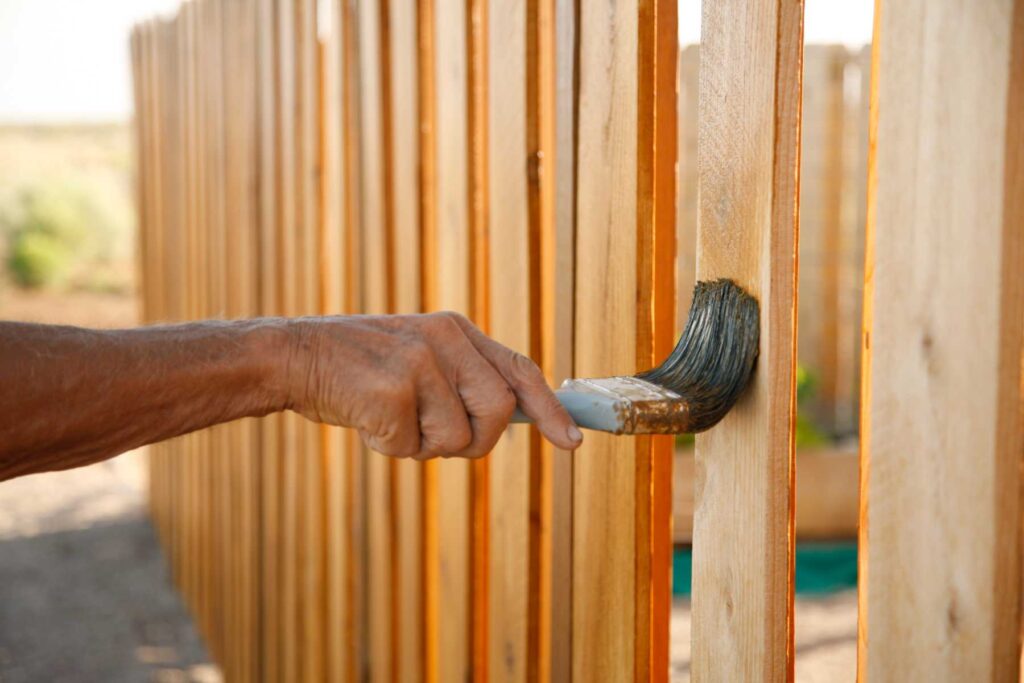Ultimate Guide to Staining Your Fence
Your Ultimate Guide on How to Stain a Fence
Fence stain is a protective coating that protects your wood fence from sun, moisture, insects, and damage. It can also be used to enhance or change the color of your fence, making it more beautiful. Most wooden fences only need to be stained every two or three years, but if you live in an area with extreme weather or temperature, your fence should be stained as soon as you notice signs of moisture intrusion. If you’re researching the best way to stain a fence or wondering can you roll stain on a fence, keep reading for your ultimate guide to how to stain a fence.

Choose the Right Fence Staining Product
You may want to ask an expert for advice on the right type of stain for your fence. A water-based stain may penetrate certain species of wood better, but an oil-based stain may offer better protection if you live in an area that gets extreme weather. If you want the natural color and grain of the wood to show through, you should choose a transparent or semi-transparent stain. If you want to change the color or appearance of the wood significantly, you should choose a solid stain. If your fence is in the sun or is at risk of moisture or pests, you should choose a protective stain.
Prepare Your Fence
Before you begin, you want to prepare your fence. Proper preparation will ensure an even application and a better result. Use a brush to remove debris and dirt from the fence. If the fence has chipped or loose paint, remove it thoroughly before staining. If the fence has rough marks or splinters, sand it before beginning. Make any necessary repairs, including replacing damaged or rotting boards, before you begin.
Check the Weather Forecast
Be sure to check the weather forecast before you begin working. The ideal temperature to stain a fence is 70 degrees Fahrenheit, but any temperature between 50-90 degrees Fahrenheit will work. If it is below 50 degrees Fahrenheit, the stain may take too long to dry, causing streaks, peeling, or cracking. If the temperature is above 90 degrees Fahrenheit, the stain may dry too quickly, leading to uneven application and streak marks. You also shouldn’t stain your fence if it is going to rain within the next 24 hours or if the outside air is extremely humid. Avoid staining wood in direct sunlight.
Use a Roller or a Paint Brush
Stir the container of wood stain before applying it, and every 15-20 minutes to make sure the texture and color stay consistent. The best way to stain a fence is to use a paintbrush or a roller. Make sure to use thin, even coats and apply the stain in the direction of the wood’s grain. This will make it look more consistent and natural. You should also work in small sections and avoid going over the same section more than once.
If You are Going to Spray, Use the Right Technique
If you have a large fence, you may want to spray the stain on so that you can work faster. Be sure to wear a mask to protect yourself from breathing in the stain as it becomes aerosolized. An airless sprayer can be used for large projects, but it requires some practice to make sure you have the right technique. An electric sprayer is easier for beginners to use as it offers more control, but it is only right for small to medium-sized fences.
Regularly Inspect, Clean, & Maintain Your Fence
After you have stained your fence, you should inspect it regularly for signs of damage, pest problems, and moisture intrusion. Clean your fence seasonally or after heavy storms, using a brush, warm water, and mild dish soap to remove dirt and debris. Do not power wash a cedar fence. Instead, use a garden hose to gently clean it, but only on a hot, sunny day when you know the fence will dry quickly. If you see signs of wear and tear, you can touch up those areas with more stain.
Call to Schedule Wood Fence Installation
Dick’s Evergreen Fence and Deck offers professional wood fence installation in the Portland, OR, area. We have more than 40 years of experience in the fencing and decking industry. We only use high-quality wood for our fences and can build them to any size or custom specifications. In addition to wood fencing, we also offer wood decks, pergolas, patio covers, and garden accents. Our premium cedar fencing is beautiful and naturally resistant to insects, decay, and rot. Call now or contact us online to schedule wood fence installation.
